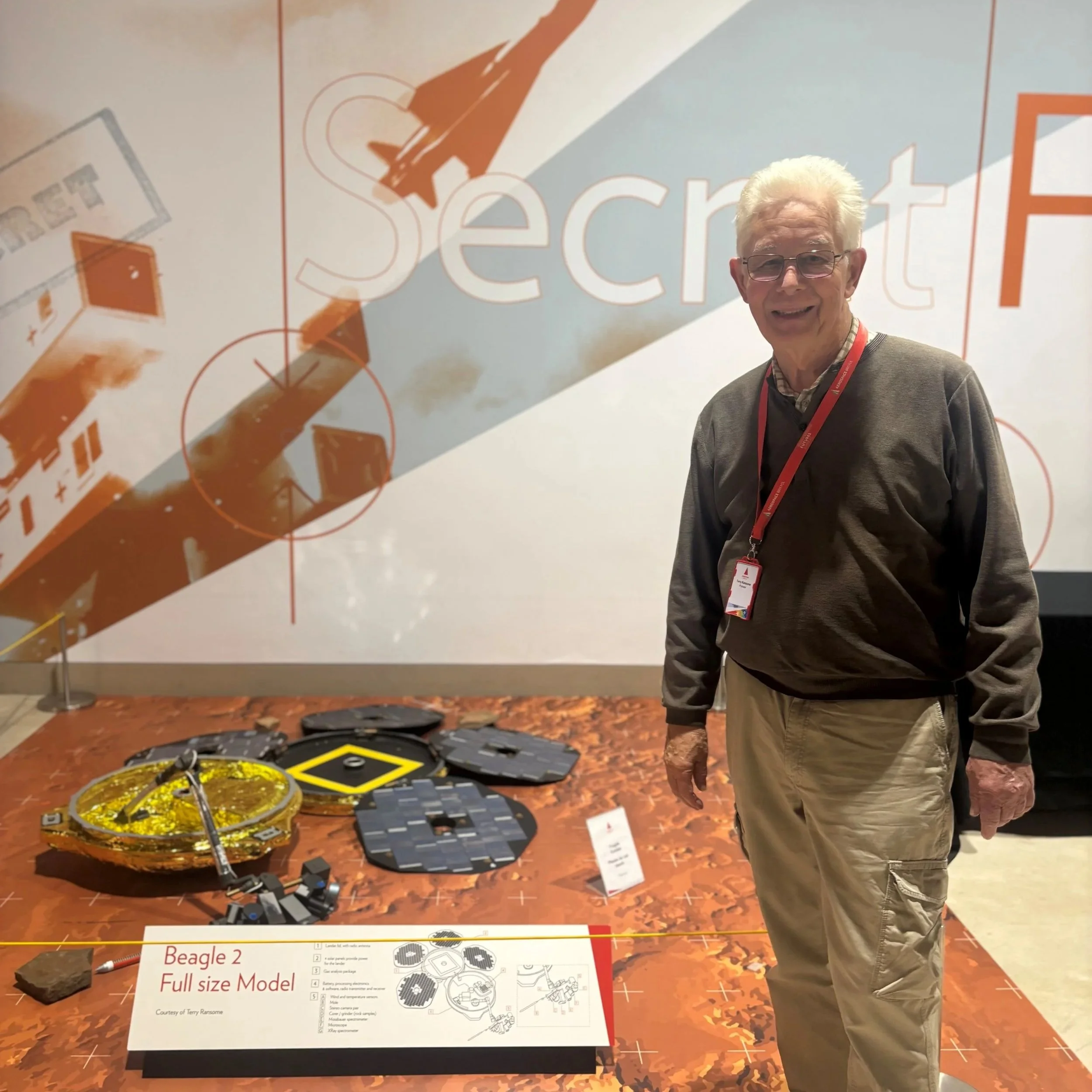Celebrating World Space Week
From 4th to 10th October every year, Aerospace Bristol celebrates World Space Week, and the achievements of the Bristol engineers, working at Filton, who contributed to over 60 spacecraft. Among these were astronomy missions including the Hubble Space Telescope, COS-B (measuring the COSmic ray Background), EXOSAT (X-Ray astronomy), Hipparcos (compiling a stellar catalogue) and Ariel 6 (Heavy Cosmic ray detection).
Terry Ransome with a replica of Beagle 2.
A replica of Sputnik 1 hanging in a museum at the Russian launch site in Baikonur, Kazakhstan, showing the small size of that first satellite! (Photo: Terry Ransome, 2003)
Do you know why World Space Week begins on 4th October every year? It’s the day in 1957 that the world’s first artificial satellite, Sputnik 1, was sent into orbit by the USSR. The UK took part in the International Geophysical Year that same year, with the aim of finding out more about the upper atmosphere and the beginnings of ‘space’. BAC at Filton was part of that – manufacturing the Raven rocket motors for the Skylark Sounding Rocket at its Banwell factory. The first Skylark entered space just 5 weeks after Sputnik was launched.
Visitors to Aerospace Bristol can see a Skylark 12 rocket, learn about satellites, and find out how work by Bristol engineers and scientists has helped to enhance our understanding of the universe.
A Skylark 12 rocket, on display at Aerospace Bristol.
Filton’s Photon Detector (within Hubble’s Faint Object Camera) gave astronomers their best look yet at a rapidly ballooning bubble of gas blasted off a star - Nova Cygni – that erupted on 19th February 1992. COSTAR refers to the Corrective Optics installed by astronauts in 1993 after Hubble’s main mirror was found to be slightly out of shape. Photo credit: Hubble/ESA
Bristol's Space team, working at Filton, contributed to several missions to explore the Earth’s magnetosphere (the magnetic and electric fields surrounding the planet). Their aim was to find out how the magnetosphere is affected by the ‘wind’ of atomic particles coming from the Sun.
Among these missions were HEOS 1 & 2, Ariel 4, GEOS 1 and 2, and the four-spacecraft Cluster mission.
This ESA diagram shows how the magnetic field is distorted by the solar wind. Four Cluster spacecraft are shown ‘dancing’ in changing configurations to obtain 3-Dimensional data.
The European Space Agency held a competition - across the all ESA Member States - to name the four Cluster spacecraft. The winner was Ray Cotton of Bristol with 'Salsa, Tango, Rumba and Samba', reflecting their cosmic dance as they changed positions!
Bristol's ‘star’ project, Envisat looked down to Earth for environmental and climatic research. Under contract to the European Space Agency, the team at Filton delivered the largest and heaviest civilian spacecraft yet built, at 8 tonnes. Launched 1st March 2002, Envisat provided data from 10 scientific instruments until 8th April 2012 when it suddenly and mysteriously fell silent.
Image: The almost-completed Envisat spacecraft. While at the European Space Technology Centre, Noordwijk, NL, Envisat was still the responsibility of Filton-based engineers and technicians.
Bristol’s first satellite contracts (in the 1960s) were with the Hughes Corporation of the USA, to participate in the Intelsat 4 series of four geostationary communications satellites.
BAC provided spacecraft structures and power systems. That led to orders for a further 12 sets for similar Intelsat 4A and Comstar spacecraft. Later, in the 1990s, BAC provided antenna mechanisms for the UK Skynet and similar NATO military communications spacecraft. Although no longer owned by the UK military, Skynet 4C, which was assembled at Filton, holds the current record for the longest operational communications spacecraft – 1990 – 2020.
Image: A photo from the early days of BAC's work on the Intelsat IV spacecraft. Probably a ‘tour of inspection’ by customer representatives, in front of a full-size mock-up of the spacecraft 1967.
Activities to enjoy at home
BUILD A ROCKET LAUNCHER
All you need is an empty squeezy bottle, a straw, some card and sticky tape and you’re ready for lift off! Download our simple guide and blast off in 3, 2, 1…
TEST YOUR DEXTERITY
Astronauts often have to carry out tricky tasks in space so it is important that their dexterity is tip-top! Here’s a fun activity you can try at home. Download our step-by-step guide >
EXERCISE LIKE AN ASTRONAUT
Astronaut’s have to stay very active even when they are in space. Have a go at some fun space themed exercise challenges.










